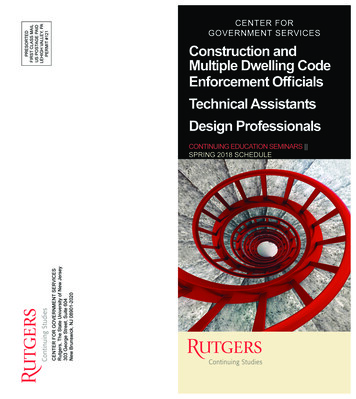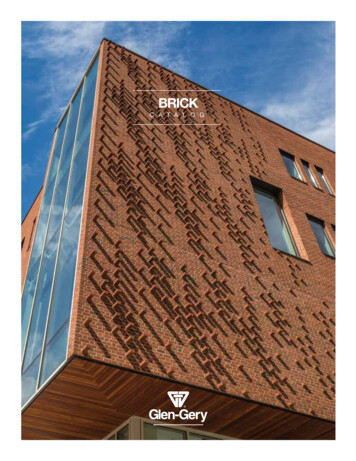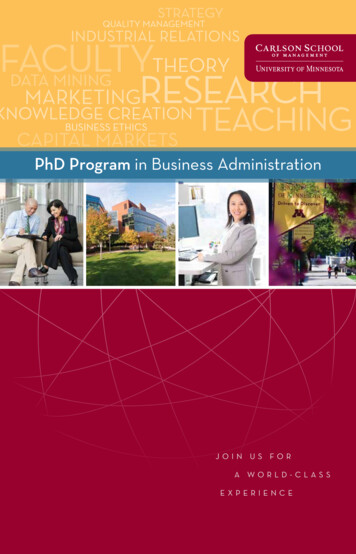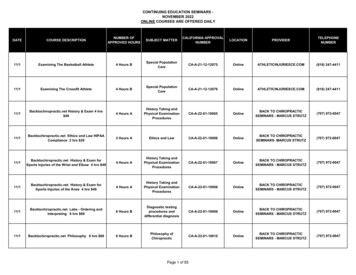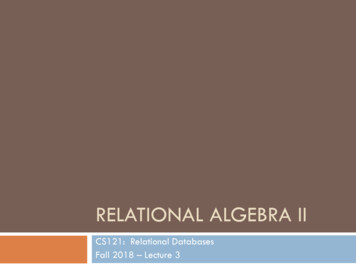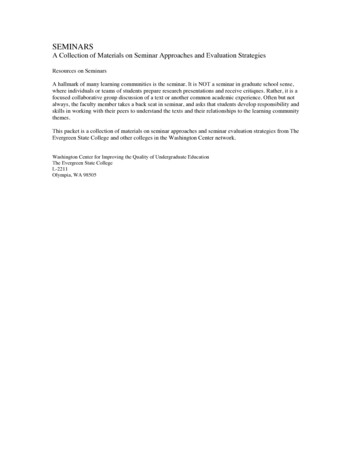
Transcription
SEMINARSA Collection of Materials on Seminar Approaches and Evaluation StrategiesResources on SeminarsA hallmark of many learning communities is the seminar. It is NOT a seminar in graduate school sense,where individuals or teams of students prepare research presentations and receive critiques. Rather, it is afocused collaborative group discussion of a text or another common academic experience. Often but notalways, the faculty member takes a back seat in seminar, and asks that students develop responsibility andskills in working with their peers to understand the texts and their relationships to the learning communitythemes.This packet is a collection of materials on seminar approaches and seminar evaluation strategies from TheEvergreen State College and other colleges in the Washington Center network.Washington Center for Improving the Quality of Undergraduate EducationThe Evergreen State CollegeL-2211Olympia, WA 98505
WHAT'S IN A SEMINAR?by Jim Harnish, North Seattle Community CollegeThe book seminar is the primary mode of learning in our coordinated studies program at NorthSeattle Community College. The seminar in a coordinated studies is what sets this class apart from othertypes of classes. So what is a seminar? How do you prepare for seminar? What and how do you learn in aseminar?A seminar brings together an interested group of learners who have done some preparation,including having read, thought about and written about a particularly good book. The solitary preparationshould include marking the text for interesting passages, reviewing those sections, organizing one'sthoughts on paper and producing significant questions that need to be explored.In the seminar the group is responsible for exploring the text and probing the ideas people havebrought from their individual reading of the text. It is a time to "mine" the text, to work it over as a group,to think aloud about it, and to test some ideas against the group. For example, the following might beoverhead in a seminar: "I don't know if this is valid but it seems that the author is saying. . . ." Or: "Here onpage 15 at the bottom of the page there is this passage [read from text]. This seems to be an importantpassage. It is worth looking at closely. . . ." Or: "This part connects interestingly with this other part."A seminar is not an arena for performance to show you've read the text or a reporting session toread your papers. It's more than a class discussion and it definitely is not a time for a lecture from an expertwho will tell the group what they should get from this book. There may be places for those activities butnot in seminar. Seminar is a special time for a unique intellectual activity. The exchange of ideas isfocused on a source (a book, play or film) and is aimed primarily at getting more deeply into the source.A good way to keep focused on the text at hand is to respond to the following three questions:1.WHAT DOES THE TEXT SAY?--Point to the exact page and paragraph so everyone canread along.2.WHAT DOES THE TEXT MEAN?-- Explain or interpret the passage in your own words.3.WHY IS THIS POINT IMPORTANT?--Agree or disagree, or compare it to other ideas orexperiences.Make sure you keep these three questions distinct, because each question forces the group todiscuss the text in different ways. The first one asks for the facts. The second searches for concepts orinterpretations behind the exact words or inferences between the lines. The third seeks an evaluation orhypothesis--your own analysis, reaction, or evaluation.Sometimes the seminar will be focused and free-flowing. Sometimes it will be searching,questioning, going deeper to understand ideas from a book, from others or from within yourself.Sometimes the group will come to some conclusions. Sometimes it will seem like a series of disconnectedactivities, like a popcorn popper, with ideas jumping around the table without clear connections. In eithercase, the seminar is a place to discover new ideas, to re-look at old ideas, or to develop insightfulconnections among ideas.The teacher's role in a seminar is, at best, to be a model of an experienced learner; not to be thefocus of attention, or the authority who will tell you what you should learn. Don't let the faculty membergive a lecture in seminar! Everyone must take responsibility for co-leading and sharing ideas.Participants must learn to actively listen to each other and to speak openly to the whole group, notjust to the leader. The group must learn to be sensitive to the needs of all. The natural talkers must be
disciplined in order to learn how to listen better. The quiet people must learn to be more assertive and toshare their insights, even if they are not comfortable doing that. Everyone should speak during eachseminar.Speak in turn and allow others to finish their thoughts. Do not interrupt one another. Silent periodsare OK. Silence gives time to process thoughts, so try to become comfortable with it. Address an idea orargument by connecting it to what someone else has said. Summarize the point you are responding to, thenprovide your own idea.Finally if things are not going well, it is our responsibility individually and collectively to putthings right. Keep taking the pulse of the group and make adjustments so that everyone can have theopportunity to have a meaningful intellectual experience in seminar. The best question to ask is not "howam I doing," but rather "how is our seminar going?"Leaving the seminar with more questions than you came with, or being somewhat confused andoverwhelmed with new ideas, is a sign your seminar is working. You will come to realize in seminar that agreat book is not something you read once and then feel satisfied you have learned all you can learn fromit. Rather, a great book is one which stimulates continuing intellectual curiosity and which demands fromyou a re-reading and a continuing discussion of it--maybe for the rest of your life.Jim Harnish, December 1995
Suggestions for SeminarsThis set of suggestions has circulated in coordinated studies programs in the communitycolleges in the Seattle area for several years; we aren’t certain who the original authorwas.Some Common Seminar Features1. Open with questions about the text:If you have questions about concepts, terms; words that you don’t fully understand, askthe seminar about them at the start. This is important for establishing common ground,for facilitating an atmosphere in which it is really okay not to know everything. It is notokay to pretend to know what one doesn’t, because that simply inhibits participation anddiminishes the richness and diversity of the group.2. Tie up the discussion with a summary:After a discussion, take a few minutes in which to summarize the major ideas discussedand the insights and conclusions arrived at. An alternative is to have five minutes ofsilence in which we can review our notes. Each person could write down the biggest idea(aha!) or the most important conclusion we established. Then, we could go around theroom for ten minutes (each person having the right to pass) everyone stating his/her biginsight. Perhaps a seminar member could gather up the big ideas, collate them, type themup. Then, we could copy them for everyone. Spending some time summing up is a goodway to reestablish a common understanding of what we have learned in this seminar. It isuseful also for building skills in summarizing, connecting ideas and synthesizing theminto meaningful generalizations. or conclusions.3. End the seminar with a brief group process discussion:How did everyone feel about today’s seminar process.? Estimate the quality of theinteractions. What worked? What didn’t? Why? Why not? Most importantly, how couldwe improve? This work, to understand our seminar process, is vitally important.4. Remember:The quality of our intellectual insight and of our interaction is usually directly related tohow we approach our texts. The text is what we share in common. We have to have somekind of common understanding of the text itself before we extend outward into what wethink of the text and what connections we bring to it from life experiences and othertexts. Thus, we must be exegetical, that is, text-centric.
Some seminar strategies:1. Bonepiling and Skeleton (Schema)-Building: Everyone throw out your ideas about the text. Build a bonepile. Everyone try to put atag on each bone. That is, record the ideas on the board. Once the ideas are out, shift gears. Begin figuring out how to construct a coherentskeleton using as many bones as possible. We may want to have a few silent minutesto review our notes and to work our connections between ideas. Are there somebones which are more important that others? Is there a femur which can help theskeleton stand up, or some vertebrae which can help it stand up straight? Do we needone skeleton or two? Are there some bones which don’t fit? (If so keep them to oneside, but don’t throw them away. They may come in handy later.) Once we have the skeleton at least roughly built, shift gears. Begin trying to flesh outthe skeleton. Try to figure out the meaning of the skeleton’s shape. Does thisskeleton look like any others we’ve built? It its heart beating and in the right place?Does it move awkwardly or naturally? Why? What adjustments or fine-tuning wouldmake it more comfortable? Are there weak spots in the body?Variations: After bonepiling, let’s take turns identifying an idea that we really like from the text.Let’s make sure our list is complete and accurate. That is, let us hear what was said.Hold off a little on what we think about what was said. Let us look over the list withan eye to common themes (ribs?), and collate them with an eye to generalization.Then, begin skeleton-building. Having built the skeleton, make sure everyone understands it and how it works. Then,write for 5 minutes on its advantages and limitations relative to the text. Does it havea good “fit?” Are there alternative ways of organizing the bones (counterskeletons)?This is a good strategy for getting ideas out, hearing as many voices as possible, checkingthat we are hearing clearly and not just overlaying our own judgments automatically. It isgood also for building skills in pattern detection, generalizing, developing schemas, andfor putting the developed schema skeleton itself into critical focus.2. Small Group/Large Group Discussionsa) Divide into groups of three or four. Develop a different question about the text foreach group to discuss. Each group chooses a recorder (a responsibility everyoneshould have at least once in the term) to jot down the group’s ideas. Discuss thequestion, leaving time to help the recorder turn the ideas in to a brief, coherentstatement which can be presented to the full seminar for further discussion/analysis.
Return to large group. Each recorder presents her group’s consensus (or lack of it).Each report is followed by further discussion.b) Divide into groups. Each group examine the text asking the big questions (BQs):What is the text about? What are the author’s main ideas? How are the ideasconveyed? What are the author’s conclusions/recommendations? What are theauthor’s claims? Are there connections between the ideas in this text and those inother texts we have read? Having worked through these questions for a period oftime, each group should formulate one issue about which to bring a question to thefull seminar group. The question should not be tricky, and the full seminar should beable to cooperate in addressing it by examining the material in the text itself.Small group seminars are useful in several ways: many people get to talk simultaneously:there is more active participation happening at any given moment. Many students arereticent to participate in a full seminar and are more comfortable testing out their ideas ina group of three or four. Small groups also facilitate experience in figuring out strategiesfor effective interaction. They can also be valuable for setting up a closely-text-centeredanalysis while reducing the white noise which sometimes occurs in the full group, whentoo many people are so anxious to talk that no one really listens.3. Brainstorming and puzzling through questionsThe full seminar begins by asking questions about the themes of the text. Some onewrites the questions on the board. A suitable number, which can be suitably discussed inthe time available, is selected and ranked. An equal amount of time is assigned for thediscussion of each question. With about one-third of the discussion time remaining, eachstudent attempts to write an integrative, summative statement in answer to one of thequestions. Perhaps a new question is raised by the answer itself. A few volunteers readtheir writing. If there are dissonances among the answers, we analyze how and why theyarose. If they seem substantial, we try to figure out if they can be resolved. This processis easily adaptable to small group processes. It is good for getting straight into theproblems, or most puzzling aspects of the text, and-for using the text in detail foraddressing the questions. It’s valuable also for moving from free discussion to summativeanalysis (pattern-finding, skeleton-building, schema development).4. Round-robinsRound-robins are good for enabling everyone to participate without interruption. Theyare also valuable for making connections/extensions, instead of making individualstatements in an unconnected series.a) Go around the seminarers one by one asking for reactions to, reflections or questionson the text. Perhaps spend 10 minutes allowing everyone to write down anidea/insight/critique before beginning. If you wish to remain thoughtfully silent, youmay pass.
b) Begin by brainstorming questions only. Begin with one question and go around, oneby one, requiring that prior to stating one’s own position/reaction/connection/analysis, one must first briefly paraphrase the main point of the previous discussant.This purpose here is to deepen and extend our understanding of a single idea by aprocess of shared accretion and accumulation, as well as to practice makingtransitions from one statement to the next.5. FishbowlsThere are numbers of variations for fishbowls. Set question, theme, or idea agenda. Four,five or six people (the “fish”) volunteer to begin the seminar discussion sitting in a smallcircle in the center of the group, with the “non-fish” watching. Only fish can talk. Nonfish should observe, listen closely, and take notes on the issues under discussion whilealso attending to the dynamics among the fish. After an agreed-upon time, the fish comeback into the full group and the discussion continues as a plenary. Or, the fishbowlcontinues with new individuals volunteering to join the chairs in the center.Another variation: After the fishbowl conversation unfolds for a designated amount oftime, everyone is silent for a few minutes, writing down the major ideas they heardgenerated by the fish, and any insights they came to about the fishes’ dynamics. The nonfish now discuss the main ideas as well as the fishbowl process, with the fishcorroborating or clarifying.Some trouble-shooting strategies1 . Problem: There are only a few dominant voices talking in seminar, and nearlyeveryone else is silent. Possible strategies: Round-robin. Fishbowl. Give each participant3 pennies or poker chips: each person spends a penny (or chip) each time he/she speaksand cannot speak again until everyone else has spent their all their pennies. Move tosmall groups, locating the dominant voices in their own group(s). Ask the group toconfront the dynamic and to consider ways to change it.2. Problem: the faculty seminar leader is dominating too much: setting the agenda,talking at length, being critical of student ideas. Possible strategies: Request a halt inongoing proceedings, state your position and ask for student input. Ask the facultymember to be quiet for a while to see what you can do on your own. Ask the facultymember to share with small student teams the power to determine seminar structure. Askthe faculty member not to intervene except to make occasional summative statements atagreed-upon times. Ask the faculty member to leave seminar for a day.3. Problem: men's voices are dominating women’s or vice versa. Possible strategies:Break into all men’s and all women’s groups, and have each discuss an issue, comingback to the full group to report and do further analysis. Each group member shouldobserve the dynamics and be prepared to comment on observed differences in dynamicsbetween the mixed and single-gender groups. Have a women’s fishbowl, then a men’s,then discuss the issues raised and the observed dynamics in full group. Have one or two
seminar members volunteer to simply keep a list of who talks. and whether what they sayis an interruption, a question, a connection, an extension, or a statement. Read the list formen and the list for women, NOTE: One gender’s interaction style is in no wayintrinsically superior to the other’s. They are often different, however. The issue is tobecome more conscious of both styles of interaction and to learn how to be conscious ofhow to use elements of both.4. Problem: Everyone is throwing out ideas and it is becoming impossible to keep trackof them all. It feels as though there is too much noise and not enough music. Possiblestrategies: Skeleton-building, round-robin with paraphrasing and connections required.Silence in which to think, write, collate notes and then establish common questions.5. Problem: No one is listening closely enough. It is as though we just don’t hear eachother’s points. Possible strategies: Round-robin or fish-bowl. Go to small groups. Requirequestions/connections/extensions subsequent to paraphrasing the comment of the priorspeaker.6. Problem: We’re not sticking to the text. We’re throwing out ideas and personalexperiences but haven’t mentioned or established a common ground about what theauthor actually said. It feels as though no one has read the book. Possible strategies: Goto the Big Questions (BQ) sheet. Agree that no one can comment unless he or she refersdirectly to the text, giving a specific page citation, and allowing time for everyone to readthe relevant material. Require seminar papers and build the discussion from points madein them. Do a jigsaw seminar: that is, go to small groups, each group taking a chapter orportion of the reading. Re-organize the groups so every group has a representative ofevery previous small group, whose job it is to “teach” their group the key ideas, themesor questions from their part of the reading.7. Problem: Ideas come out so rapidly in seminar that some students say they cannot keepup and cannot concentrate. Possible strategies: Slow things down. Have silence for 5-10minutes so that everyone can write ideas down and get specific and focused. Suggest thatwe formulate questions to guide discussion. Bring in a large ball of wool: only the personholding the ball of wool can speak. The speaker shall choose who to throw the ball tonext, while holding onto the end of the strand of wool. Of itself, this will cool thingsdown. In addition, we will be able to see, by looking at the spider web we are creating,the distribution of offerings to the discussion. Then we can ask if the pace is slowenough. If not, we can require that before making one’s own comment, one mustparaphrase that of the previous speaker. In addition we can agree to stop for silence atregular times in order to process what we’ve heard up to that point.
Approaches to Assessment in the Collaborative LearningSeminar/DiscussionK. Ann McCartneyContributors to this article explain their assumptions about the practice ofseminars and offer several models for assessing seminar process in order to helpstudents engage in the active ways that result in effective seminaring.The collaborative learning seminar has long been a central component in learningcommunity and coordinated studies courses and has increasingly found its way intotraditional, stand-alone classes. The seminar, when it works, actively engages students inlearning.How can we promote this active engagement in learning? Faculty and students alikebecome frustrated when the seminar does not seem to work. Our own frustration whenthe seminars didn't work and our excitement when they did, led each of us to considerusing assessment procedures to nourish the ongoing life of the seminar. When assessmentprocedures are used this way, the procedure becomes an integral component of thelearning and thus vital to the quality of the seminar. Through ongoing assessment,students are encouraged to be reflective, to think about their own thinking, to becomeactively and responsibly engaged with how the seminar is working and what they aredoing as part of it.We have experimented with several different assessment approaches and instruments inour seminars. This section of the handbook is organized around the questions that led usto develop our instruments: What do we mean by seminar? What is the goal of this typeof seminar ? What is our philosophy of assessment in this setting? How do we assess ourseminars? (Examples of a few assessment instruments that we use are located in theappendices of this article and the next.)What Do We Mean by Seminar?The vision of the seminar is crucial. The type of seminar we are talking about is not aclass discussion with its usual instructor-student interaction. It is not a debate withstudents focusing on defending a particular point of view and critiquing the view ofothers. It is not a graduate school seminar where students present their papers for criticalreview. Nor is it a cooperative learning group or workshop which focuses on problemsolving or creating a specific product.If a seminar is not these things, what is it? Perhaps three images will help to clarify ourvision of the seminar.Imagine a vase sitting in the middle of the seminar circle. Each seminar participant cansee only part of the vase. Each participant describes the vase from her particular
perspective. When all become involved in sharing their perspectives and workingtogether to create a complete picture of the vase (including the parts none of them can seesuch as the inside and the bottom), then they are transformed into active learners andcreators of knowledge. (See how Margaret Scarborough uses this imagery in her article,"Circumscribing Seminar Space.")Imagine a jazz combo. Each instrument is individual and has an important part to play.There is no musical score, no predetermined composition to simply replicate, noconductor who controls what each instrument does, no set part for each player. Each mustlisten to and play off the others and respond while being intent upon his own expressionof the improvisation. Each member goes his own way in concert with the group. Thecreation of the jazz combo is spontaneous, dynamic, and never the same. The jazzexperience gives voice to each unique component while creating a unified composition,Imagine building a structure. To build a structure, you need a solid foundation, stable,strong enough to hold the structure. If you make any modifications in the plan for thestructure, you must recheck and strengthen the foundation. Then you need the buildingmaterials -- the nails, screws, wood, etc. Those materials must be delivered to the site.But it is not enough just to dump out the materials; you must somehow organize them,grouping them where they are needed and with what they are needed. As you do this, youcan start to build the frame for your structure. To finish the structure and make it usable,you must fill in the frame with wall board, doors, windows, and all the details whichmake this building unique.The images of the vase, jazz combo, and the building of a structure begin to capture ourvision of the seminar. We see the seminar as the creation of a learning space in which. inthe words of Parker Palmer’, “the community of truth is practiced,” truth as “an eternalconversation about things that matter, conducted with passion and discipline” (12). Theheart of our conception of the seminar is the development and creation of a learningcommunity which provides a safe space for learners to bring their knowledge andexperience to interact with other learners and with texts, to create meaning together.The seminar creates a space where respect for other learners is paramount in the midst ofthe exploration of ideas and concepts. While the seminar should be a safe place, it is notnecessarily a comfortable place. The exploration of new ideas and concepts can threatenstudents’ already established meanings. Students are encouraged to take risks in theseminar, to assert long-cherished ideas about the world and struggle to reshape oldknowledge and/or create knowledge with others. Students engage with and reflect on thematerial and each other. In this way, risk and respect become polarities that togethercreate the learning environment.The seminar is not just another learning strategy that is appropriate to those studentswhose learning style works best in a group, but in itself plays an essential role in learning.A good seminar is a powerful tool of learning for all students. It is the collaborativecontext that shapes meaningful learning. As Paulo Friere asserts,
In the act of thinking about the object s/he cannot think without the coparticipation of another Subject. There is no longer an “I think” but “we think.” Itis the “we think” which establishes the “I think” and not the contrary. (137)This is echoed by Stephen Brookfield in his book on adult learning:There is a limit to the extent to which any individual can engage in self-scrutinywithout the stimulus that fellow learners can supply . . . But it is when one’snascent, inchoate ideas and concepts are tested out in the’ company of others thata certain creative tension comes into play. (135-136)The seminar experience is both an instance of learning and an instrument of learning. It isan end, not just a means. Participants find their voice, they commit to working withothers, and the implications extend far beyond the seminar. In this process, the wordseminar becomes a verb. It is something that we do together. The defining aspect of theseminar is that students learn actively; they are constructing their knowledge throughlistening to others, speaking their ideas and creating meanings. Students are encouragedto do the “important things that need to be done to information by an educated adult:choosing it and finding it, weighing it, criticizing it, analyzing it, comparing it, reflectingon it . . ."What is the Goal of the Seminar?The overall goal of the seminar is to create a space and time for students’ engagementengagement on the idea level (the intellect, the intuitive, the emotions). the individuallevel (unique perceptions), and the social level (community). Intellectually, the seminarserves to help students explore a diversity of perspectives, to see the complexity andambiguity of the content, to help them recognize the underlying assumptions of theirhabitual ideas and behaviors, to develop higher level critical thinking ability, and toencourage active listening. Emotionally, the seminar serves to increase students’ affectiveconnections to the content, to show students they are heard and that their voices matterand their experiences and thinking are valued. On the individual level, the seminar helpsstudents to test, expand, revise, create their individual meanings in the context of thegroup. Socially, the seminar serves to build relationships with other learners in a way thatcreates a community of learners who bring knowledge to life with mutual exploration,both consensus and dissensus (“an agonistic framework of conflict and difference . . ."(609). In this community, knowledge emerges, is brought to life in the social interactionof the learners. The total engagement of the learners-intellectually, individually andsocially-leads to the learning.The seminar has no expected formal product. The product is meaning, not an answer or atask accomplished. In fact, more questions may be raised than answered. If there is aproduct, it is inspired learners: learners who are developing a habit of inquiry thattransforms the way they approach issues, knowledge, others. These are habits of mindand heart, a search for connectedness and relatedness.
What is Our Philosophy of Assessment in the Seminar?In our seminars, assessment is not a terminal episode; it is not primarily to grade thestudents. For us, assessment is formative: our assessment can be a monitoring tool toprovide information that will empower students to become more effective seminaringparticipants. Seminar assessment helps students to consciously develop seminaringbehaviors, to work more effectively in the seminar through conscious development ofproductive behaviors, and to develop behaviors that take them beyond the seminar.We believe seminaring is not something that comes naturally; it needs to be taught.Assessment of the seminar and participation in the seminar can help participants learn toseminar. Since students approach a seminar situation with different notions aboutlearning, from different cultures and learning styles, with varying levels of interactiveskills, we need a clear vision of the seminaring process and behaviors. In our view,assessment instruments offer a notion of what is possible, point toward how to achievethe possible, give feedback on progress, and enable users to talk about, intervene ifnecessary, and consciously improve their seminaring.Thus, the sample assessment tools at the end of this article and the next provideinformation to the students to encourage meta-communication about seminaring, to shapeand hone to peaceful, productive ways of discourse; to participate fully in a communityof learners.How do We Assess Our Seminars?At the heart of effective
SEMINARS A Collection of Materials on Seminar Approaches and Evaluation Strategies Resources on Seminars A hallmark of many learning communities is the seminar. It is NOT a seminar in graduate school sense, where individuals or teams of students prepare research presentations and receive critiques. Rather, it is a
